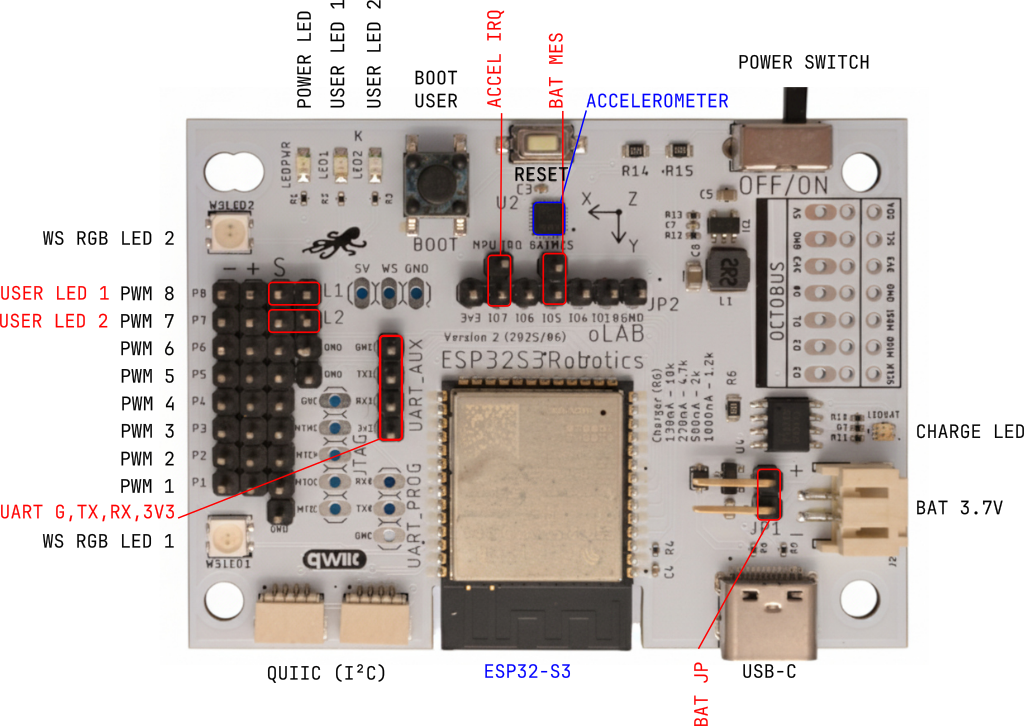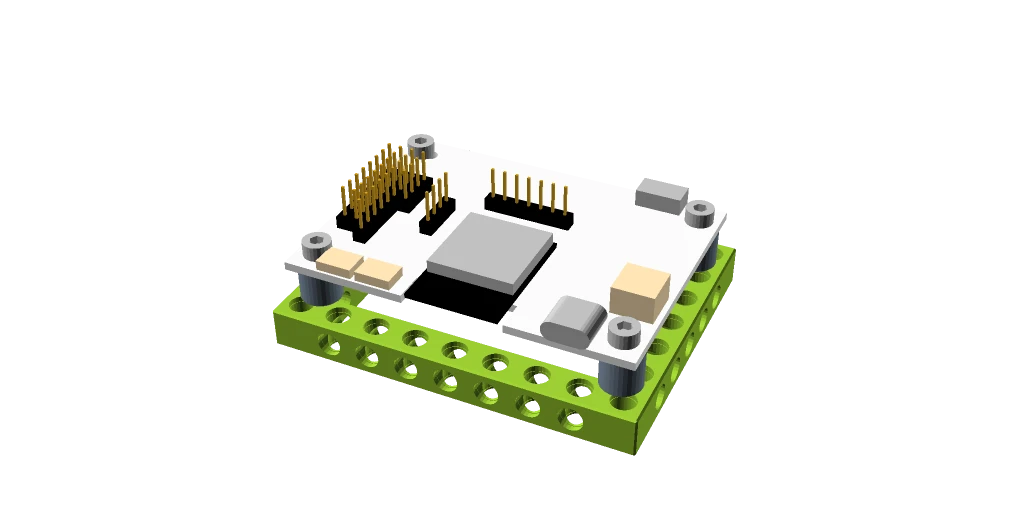ESP32-S3 Robotic Board: The Heart of Your BitBeam Robot
The ESP32-S3 Robotic Board is a compact and highly integrated development board designed specifically for ambitious robotics and automation projects. Thanks to the combination of the powerful ESP32-S3 chip and a complete set of peripherals, it eliminates the need for multiple expansion boards – everything for building a robot is integrated onto a board measuring 68 mm x 50 mm.

Assembled ESP32-S3 Robotics Board with peripheral labels.
Key Features and Connectivity
The board uses the ESP32-S3 microcontroller, which provides sufficient performance and memory for complex tasks.
- Microcontroller: ESP32-S3 WROOM-1
- Memory: 16 MB Flash, 8 MB PSRAM
- Wireless Connectivity: Integrated 2.4 GHz Wi-Fi (802.11 b/g/n) and Bluetooth 5.0 (LE) connection.
This allows for the creation of IoT (Internet of Things) applications and remote control of robots.
- Optimized for Robotics: The board is designed for quick and easy prototyping, with an emphasis on connecting servo motors and sensors.
- Dimensions: Compact size 68 mm x 50 mm.
Power Supply and Energy Management
The board offers flexible power options, which are crucial for mobile robotic projects.
- Power and Programming Connector: USB-C. Power can be easily controlled by the integrated switch.
- Battery Connector: Connection of a Li-ion/Li-pol battery type is handled via a jumper.
- Charging Circuit: Uses the TP4056 chip with a charging current of 270 mA.
- Charging Status Indication: Dual-color LED:
- Red: Battery charging is in progress.
- Green: Charging completed.
- Green blinking: Battery is not connected.
Peripheral and I/O Interfaces
The board provides extensive possibilities for connecting actuators and sensors:
Interface for Servomotors and PWM
A total of 8 PWM outputs are available with connectors (GND, VCC, Signal, Extra) designed primarily for servomotors and other peripheral devices.
| Output | GPIO Pin | Extra | Output | GPIO Pin | Extra |
|---|---|---|---|---|---|
| PWM_1 | 21 | PWM_5 | 16 | GND | |
| PWM_2 | 47 | PWM_6 | 03 | GND | |
| PWM_3 | 09 | PWM_7 | 48 | LED2 | |
| PWM_4 | 15 | PWM_8 | 14 | LED1 |
Communication Buses and Sensors
- I²C Connectors (Qwiic): Two Qwiic type connectors allow easy and quick connection of I²C sensors and modules without the need for soldering. (SDA: GPIO 01, SCL: GPIO 02)
- Sensor: Integrated MPU6500 Accelerometer and Gyroscope for motion and orientation detection. (Connected to I²C, Address: 0x68 (104)).
- UART: Exposed pins for UART1 for serial communication (TX: GPIO 17, RX: GPIO 18).
Indication and Control
- Buttons:
- BOOT (GPIO_00): Button for entering programming mode or as user I/O.
- RESET: Button for microcontroller reset.
- User LEDs (Optional): Two standard single-color LED diodes for user purposes, which can be connected to the PWM outputs using jumper pins (jumpers).
- LED1 (Red): Connectable via jumper to PWM_8 / GPIO_14.
- LED2 (Green): Connectable via jumper to PWM_7 / GPIO_48.
- RGB Neopixel LED (WS2812B): Two addressable RGB LED diodes wired in series, ideal for visual robot status indication.
For connecting additional external WS LED strips or modules, an unpopulated connector (pads) is prepared on the board, which must be soldered on.
- Indicator LEDs (System): These LEDs signal the power and charging status and are not software-controllable by the microcontroller.
- POWER_LED - Signals that the board is powered on/supplied (BAT/USB).
- CHARGE_LED - Dual-color LED, signaling the battery charging status (Red = Charging, Green = Charging completed).
Prepared Extensions (Unpopulated Connectors)
Soldering points (pins) are prepared on the board that are not typically fitted with connectors. These points allow the board to be expanded with additional peripherals, debugging interfaces, or special buses. Fitting these connectors requires soldering.
| Interface | Description | Pin Order (Physical) |
|---|---|---|
| JTAG | Interface for complex code debugging (Debugger). | MTDI, MTDO, MTCK, MTMS, GND |
| UART PROG (UART 0) | Primary UART for programming and basic serial communication (TX0, RX0). | GND, TX, RX |
| WS LED | Option to connect an external WS2812B (Neopixel) strip. | 5V, WS (Signal), GND |
| OCTOBUS | Access to key SPI and I²C pins for high-speed modules. | Row 1: D3, D2, D1, 3V3, GND, 5V
Row 2: SCLK, MISO, MOSI, GND, 3V3, SCL, SDA
|
Physical Integration into BitBeam
The board is designed for seamless integration into the BitBeam construction kit.
- Mounting: M3 screw holes are used for secure and reliable mounting of the board into the structure.
- Holders: Several different STL models are available for download, which ensure secure mounting of the board in any BitBeam structure.
- These models can be printed on a 3D printer.
- Box OctopusLAB FIRST2/ESP32/EDU/FET Board Beam 7x11: bb-bd-oedu-7x11.stl
- Box OctopusLAB FIRST2/ESP32/EDU/FET Board Beam 9x9: bb-bd-oedu-9x9.stl
- Frame OctopusLAB FIRST2/ESP32/EDU/FET Board O Beam 7x9: bb-bd-oedu-o-7x9.stl

The ESP32-S3 Robotic Board attached to a frame from the BitBeam construction kit.
Programming and Examples
The board is fully compatible with development tools for ESP32, including Arduino IDE, NodeMCU Lua, and MicroPython.
MicroPython code examples and other documentation for working with the board in MicroPython can be found on the Octopus Lab website: https://www.octopuslab.cz/esp32_s3_robotics
Table of ESP32-S3 Robot Board Outputs and their Use.
Comparison with Competition
The ESP32-S3 Robotic Board presents a more powerful integrated alternative to frequently used modular solutions, such as the combination of the BBC Micro:bit and the Elecfreak Wukong board.
| Feature | ESP32-S3 Robotic Board | BBC Micro:bit + Wukong Board |
|---|---|---|
| Microcontroller | ESP32-S3 (Integrated Wi-Fi/BT) | NXP KL27Z + nRF51822 (Bluetooth) |
| Flash | 16 MB | 512KB |
| RAM | 8 MB PSRAM | 128 KB |
| Connectivity | Wi-Fi (802.11 b/g/n), Bluetooth 5.0 (LE) | Bluetooth 5.0 |
| Motor/Servo Driver | 8x PWM | 8x PWM, 2x DC |
| LED | 2x RGB Neopixel, LED1 Red, LED2 Green | 25x LED Red + 4x RGB Neopixel |
| Accelerometer | MPU6500 - Accelerometer + Gyroscope + Thermometer | LSM303AGR - Accelerometer + Compass |
| Buttons | Boot | A, B, Touch |
| Battery Charging | TP4056 + Li-ion / Li-Pol (not included) | Li-ion 400mAh |
| Architecture | All-in-one robotic module | Modular (two boards) |
While the Micro:bit with the Wukong board offers a great introduction to coding and has a large community, the ESP32-S3 Robotic Board provides a more powerful microcontroller with Wi-Fi and a complete set of features for robotics in one compact unit. It is the ideal solution for builders who prefer ease of wiring and maximum performance for more complex code and wireless communication.
Where to Get the Board?
You can find the ESP32-S3 Robotic Board in our e-shop.
Community and Support
We believe the best path to learning is through sharing experiences. If you have any questions about the ESP32-S3 Robotic Board, programming, or are unsure about technical details in the documentation, please do not hesitate to ask.
Our official discussion forum is the primary platform for:
- Technical Support: Get answers to questions about electronics and code.
- Discussion: Share your projects, ideas, and tips for working with the construction kit.
- Feedback: Help us improve the board and documentation.
Join our community and develop your skills with other creators.
Discuss this board directly on the forum: Topic for ESP32-S3 Robotic Board



